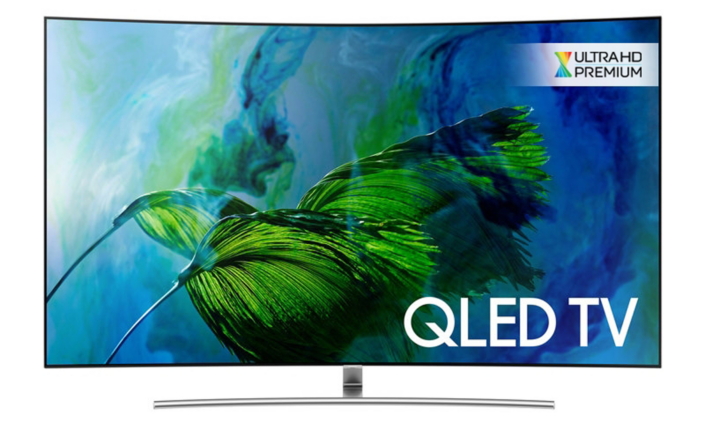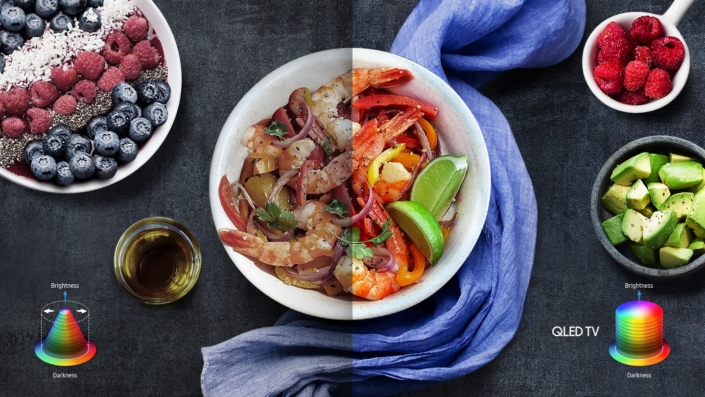Why QLED Matters for 4K HDR Content

If you enjoy browsing the newest TVs when visiting your local big box store or are among the millions who subscribe to streaming movie and TV services, it’s very likely you’ve come across the term 4K HDR by now.
As definitions, 4K refers to a screen resolution of 3,840 x 2,160 pixels, or four times the level of full high definition (Full HD) at 1,920 x 1,080 pixels. HDR, which stands for high dynamic range, is a recently introduced technology that dramatically enhances contrast ratio (or how bright and dark a TV can get) as well as a TV’s ability to express many more brilliant colors to display content perfectly true-to-the-source. In fact, with the significant difference that HDR provides, many experts have taken to calling it the ‘future of TV’.
While both 4K and HDR are advancements in their own rights, combined together, 4K HDR content takes picture quality to a whole new level and is simply jaw dropping in terms of the utter realism, brilliant color, and immersive experience it provides. With no hyperbole intended, 4K HDR delivers a TV viewing experience which simply hasn’t been seen before.
Given the expectations for how 4K HDR will re-shape the industry, major content services like Amazon, Netflix, YouTube and others are already providing content in 4K HDR, with the number of titles expanding daily. New 4K HDR TVs and HDR media players are also being introduced to the market at a rapid pace.
Choosing the Right 4K HDR TV
In line with this trend, if you’re currently on the market for a new TV, it makes sense to consider one that is 4K HDR enabled. However, with people still learning about this new technology, how do you choose the ideal 4K HDR TV that will display 4K HDR content in the way it deserves?
The easiest way will be to look for the ULTRA HD PREMIUM™ logo which is issued by the UHD Alliance for products and services that meet or exceed strict performance levels for 4K resolution, HDR, and wide color spectrum.

To provide, however, further understanding of a TV able to do justice to 4K HDR content, it’ll be helpful to look at the example of Samsung’s new QLED TV. Introduced at this year’s CES, and quickly capturing industry attention, the new QLED TV provides insights into three key criteria when it comes to choosing the best 4K HDR TV for 4K HDR content:
- What is the TV’s color volume?
- Does the TV utilize advanced HDR (at least 1000nit image source)?
- How is the TV’s brightness and contrast?
Let’s explore each of these criteria more deeply.
Key Criteria #1: Color Volume
To display 4K HDR content at its best, it’ll be important to become familiar with the concept of color volume, and to look for a TV that offers 100% color volume.
While Samsung Newsroom has covered color volume in-depth in a previous post, this exacting standard of color expression measures two elements of the TV with three-dimensional space – the color gamut and the brightness level. The color gamut looks at the amount of colors that can be displayed physically. The peak brightness represents the display’s maximum brightness level. The larger the color gamut and the higher the brightness, the bigger the color volume of the TV.
For its part, Samsung’s new QLED TV combines quantum dot light and RGB color for 100 percent color volume expression—the first TV to be validated as such by the world-class testing and certification association, Verband Deutscher Elektrotechniker (VDE).

QLED is able to achieve 100% color volume and precise colors through the unique combination of quantum dot light and a pure RGB color filter
What this means for 4K HDR content is that Samsung QLED will display the content with absolutely precise color accuracy, as realistic as it gets, and exactly as the director intended.

Key Criteria #2: Advanced HDR Utilization
While HDR, as mentioned earlier, is a relatively recent advancement, it’s important to understand that there are already variations to this new technology in particular involving the nit level (or visible-light intensity) a particular HDR-type is able to capture.
When it comes to 4K HDR content, the key will be to keep in mind the requirement of 1000nit. In short, a TV that cannot capture a 1000nit image source will not be able to depict content, particularly 4K HDR, completely true-to-the-source.
Different from other sets being introduced to the market, Samsung took the initiative to integrate HDR capabilities able to express a peak brightness of up to 1500-2000nit (surpassing the 1000nit requirement) into its QLED TV. Samsung QLED TV’s advanced HDR capability ensures it is able to depict 4K HDR content with perfect true-to-the-source accuracy, just as the directors intended.

Advanced HDR technology expresses every detail just as the director intended
Key Criteria #3: Brightness and Contrast
The final criteria to consider in choosing the ideal 4K HDR TV is the TV’s brightness and contrast, specifically the peak levels of brightness the TV is able to achieve. In addition to deep blacks, many experts consider a TV’s brightness levels to be key to outstanding picture quality given the significant difference of varying brightness levels to the human eye. Brightness is also critical given the different lighting conditions of many home and other environments, and will be a decisive factor in ensuring that 4K HDR content is getting the best expression possible.
Samsung’s new QLED TV utilizes 32 precision brightness block adjusters, to automatically adjust the brightness level block by block, making dark images appear darker and bright images appear brighter.

Samsung QLED TV’s brilliant light source, based on quantum dot, also helps it produce exceptional brightness and contrast in any setting ensuring 4K HDR content will get the play it deserves in diverse home and other environments.
As the year continues, it’s no doubt you’ll be hearing much more about 4K HDR – from new content and titles to TV and media hardware. The dawning of the 4K HDR era promises to be an exciting one, and we hope you stay tuned as Samsung continues to introduce further innovations in this area.
Products > TVs & Displays
For any issues related to customer service, please go to samsung.com/my/support for assistance.
For media inquiries, please contact samsung@priority.net.my.